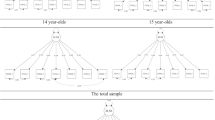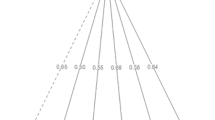Abstract
The psychometric properties of the MultidimensionalStudents’ Life Satisfaction Scale (MSLSS: Huebner, 1994) were assessed with a sample of adolescents fromgrades 9–12. Results of confirmatory factor analysessupported the hypothesized factor structure. Further,evidence for the convergent and discriminant validityof the instrument was obtained. Acceptable internalconsistency estimates for the Total and domain scoreswere also obtained. These psychometric propertieswere similar to findings of the MSLSS with youngerchildren. Limitations and future researchconsiderations were discussed.
Similar content being viewed by others
References
Andrews, F. M. and J. P. Robinson: 1991, ‘Measures of subjective well-being’, in J. P. Robinson, P. R. Shaver and L. S. Wrightman (eds.), Measures of Personality and Social Psychological Attitudes (Vol. 1). (Academic Press, San Diego, CA).
Andrews, F. M. and S. B. Withey: 1976, ‘Social Indicators of Well-Being: America’s Perception of Life Quality’ (Plenum Press, New York).
Annas, J.: 1993, ‘The Morality of Happiness’ (Oxford University Press, New York).
Argyle, M.: 1987, ‘The Psychology of Happiness’ (Routledge, London).
Asher, S. R., S. Hymel, and P. D. Renshaw: 1984, ‘Loneliness in children’, Child Development 55, pp. 1456–1464.
Bender, T. A.: 1997, ‘Assessment of subjective well-being in children and adolescents’, In G. Phye (ed.), Handbook of Classroom Assessment: Learning, Achievement, and Adjustment (Academic Press, San Diego, CA).
Basche, M. F.: 1995, ‘Doing Brief Psychotherapy’ (Basic Books, New York).
Bentler, P. M.: 1994, ‘Forward’, in B. M. Byrne (ed.), Structural Equation Modeling with EQS and EQS/Windows (Sage, Thousand Oaks, CA), pp. vii–ix.
Browne, M. W. and R. Cudek: 1993, ‘Alternative ways of assessing model fit’, in K. A. Bollen and J. S. Long (eds.) Testing Structural Equation Models (Newbury Park, Sage), pp. 136–162.
Cliff, N. and D. J. Krus: 1976, ‘Interpretation of canonical analysis: Rotated vs. unrotated solutions’, Psychometrika 41, pp. 35–42.
Costa, P. T. and R. R. McCrae: 1992, Revised NEO Personality Inventory (NEO PI-R) and NEO Five-Factor Inventory Professional Manual’ (Odessa, FL: Psychological Assessment Resources).
Cowen, E.: 1991, ‘In pursuit of wellness’, American Psychologist 46, pp. 404–408.
Cowen, E.: 1994, ‘The enhancement of psychological wellness: Challenges and opportunities’, American Journal of Community Psychology 22, pp. 149–179.
Crowley, S. L. and X. Fan: 1997, ‘Structural equation modeling: Basic concepts and applications in personality assessment research’, Journal of Personality Assessment 68, pp. 508–531.
DeNeve, K. M. and H. Cooper: 1998, ‘The happy personality: A meta-analysis of 137 personality traits and subjective well-being’, Psychological Bulletin 124, pp. 197–229.
Dew, T.: 1996, ‘The preliminary development and validation of a multidimensional life satisfaction scale for adolescents’, Unpublished doctoral dissertation (University of South Carolina, Columbia).
Diener, E.: 1984, ‘Subjective well-being’, Psychological Bulletin 95, pp. 542–575.
Diener, E.: 1994, ‘Assessing subjective well-being: Progress and opportunities’, Social Indicators Research 31, pp. 103–157.
Diener, E., E. M. Suh, R. E. Lucas, and H. L. Smith: 1999, ‘Subjective well-being: Three decades of progress’, Psychological Bulletin 125, pp. 276–302.
Diener, E. and M. Diener: 1995, ‘Cross-cultural correlates of life satisfaction and self-esteem’, Journal of Personality and Social Psychology 68, pp. 653–663.
Diener, E. and R. J. Larsen: 1984, ‘Temporal stability and cross-cultural consistency of affective, behavioral, and cognitive responses’, Journal of Personality and Social Psychology 47, pp. 871–883.
Durlak, J. A. and A. M. Wells: 1997, ‘Primary prevention mental health programs for children and adolescents: A meta-analytic review’, American Journal of Community Psychology 25, pp. 115–152.
Epstein, J. and J. M. McPartland: 1977, ‘The Quality of School Life Scale’, (Riverside, Riverside, CA).
Floyd, F. J. and K. F. Widaman: 1995, ‘Factor analysis in the development and refinement of clinical assessment instruments’, Psychological Assessment 7, pp. 286–299.
Frisch, M. B., J. Cornell, M. Villenueva and R. J. Retzlaff: 1992, ‘Clinical validation of the Quality of Life Inventory: A measure of life satisfaction for use in treatment planning and outcome assessment’, Psychological Assessment 4, pp. 92–101.
Furr, R. M. and D. C. Funder: 1998, ‘A multimodal analysis of personal negativity’, Journal of Personality and Social Psychology 74, pp. 1580–1591.
Greenspoon, P. J. and D. H. Saklofske: 1997, ‘Validity and reliability of the Multidimensional Students’ Life Satisfaction Scale with Canadian children’, Journal of Psychoeducational Assessment 15, pp. 138–155.
Harter, S.: 1989, ‘Causes, correlates, and the functional role of global self-worth: A life span perspective’, In J. Kolligan and R. Sternberg (eds.), Perceptions of Competence and Incompetence Across the Life Span (Yale University Press, New Haven, CT), pp. 67–100.
Headey, B., R. Veenhoven, and A. Wearing: 1991, ‘Top-down versus bottom-up theories of subjective well-being’ Social Indicators Research 24, pp. 81–100.
Henry, C. S., D. L. Ostrander, and S. G. Lovelace: 1992, ‘Reliability and validity of the Adolescent Family Life Satisfaction Index’, Psychological Reports 70, pp. 1223–1229.
Homel, R. and A. Burns: 1989, ‘Environmental quality and well-being of children’, Social Indicators Research 21, pp. 133–158.
Hoyle, R.H. and A. T. Painter: 1995, ‘Writing about structural equation models’, in R. H. Hoyle (ed.), Structural Equation Modeling: Concepts, Issues, and Applications (Sage, Thousand Oaks, CA).
Huebner, E. S.: 1991b, ‘Correlates of life satisfaction in children’, School Psychology Quarterly 6, pp. 103–111.
Huebner, E. S.: 1994, ‘Preliminary development and validation of a multidimensional life satisfaction scale for children’, Psychological Assessment 6, pp. 149–158.
Huebner, E. S.: 1997, ‘Happiness and life satisfaction’, in G. Bear, K. Minke and A. Thomas, (eds.), Children’s Needs II. (National Association of School Psychologists, Washington, DC), pp. 271–278.
Huebner, E. S. and G. Alderman: 1993, ‘Convergent and discriminant validity of a children’s life satisfaction scale: Its relationship to self-and teacher-reported psychological problems and school functioning’, Social Indicators Research 30, pp. 71–82.
Huebner, E. S. and T. Dew: 1996, ‘The interrelationship of positive affect, negative affect, and life satisfaction in an adolescent sample’, Social Indicators Research 38, pp. 129–137.
Huebner, E. S. and R. Gilman: 1998, ‘Children’s perception of the quality of their lives: A neglected component in the psychoeducational assessment of children’s well-being’, Paper presented at the annual meeting of the National Association of School Psychologists, Orlando Fl.
Huebner, E. S., W. Drane, and R. F. Valois: in press, ‘Adolescents’ perceptions of their quality of life’, School Psychology International.
Huebner, E. S., R. Gilman, and J. E. Laughlin: 1999, ‘A multimethod investigation of the multidimensionality of children’s well-being reports: Discriminant validity of life satisfaction and self-esteem’, Social Indicators Research 46, pp. 1–22.
Huebner, E. S., J. E. Laughlin, C. Ash and R. Gilman: 1998, ‘Further validation of the Multidimensional Students’ Life Satisfaction Scale’, Journal of Psychoeducational Assessement 16, pp. 118–134.
Kamman, R., M. Farry, and P. Herbison: 1984, ‘The analysis and measurement of happiness as a sense of well-being’, Social Indicators Research 15, pp. 91–116.
Keith, T. Z.: 1999, ‘Structural equation modeling in school psychology’, in C. R. Reynolds and T. B. Gutkin (eds.), Handbook of School Psychology (3rd ed.) (Wiley, New York), pp. 78–107.
Lewinsohn, P., J. Redner, and J. Seeley: 1991, ‘The relationship between life satisfaction and psychosocial variables: New perspectives’, in F. Strack, M. Argyle and N. Schwartz (eds.), Subjective Well-Being (Plenum Press, New York), pp. 141–169.
Lucas, R. E., E. Diener and E. Suh: 1996, ‘Discriminant validity of well-being measures’, Journal of Personality and Social Psychology 71, pp. 616–628.
McCullough, G., E. S. Huebner and J. E. Laughlin: 1999, ‘Life events, self-concept, and positive well-being’, Manuscript submitted for publication.
Marsh, H. W.: 1990, ‘Manual for the Self-Description Questionnaire-I’ (University of Western Sydney, Campbelltown, NSW, Australia).
Marsh, H. W.: 1990, ‘Manual for the Self-Description Questionnaire-II’ (University of Western Sydney, Campbelltown, NSW, Australia).
Marsh, H.W., J. K. Antill, and J. D. Cunningham: 1989, ‘Masculinity, femininity, and androgyny: Bipolar and independent constructs’, Journal of Personality 57, pp. 625–663.
Marsh, H.W., K. T. Hau, J. R. Balla, and D. Grayson: 1998, ‘Is more ever too much? The number of indicators per factor in confirmatory factor analysis’, Multivariate Behavioral Research 33, pp. 181–220.
Okun, M. A. and W. A. Strock: 1987, ‘The construct validity of subjective wellbeing measures: As assessment via quantitative research syntheses’, Journal of Community Psychology 15, pp. 481–492.
Pavot, W. and E. Diener: 1993, ‘Review of the Satisfaction with Life Scale’, Psychological Assessment 5, pp. 164–172.
Reynolds, C.R. and R. W. Kamphaus: 1992, ‘Manual for the Behavioral Assessment System for Children’, (American Guidance Service, Inc., Circle Pines, MN).
Rindskopf, D. and T. Rose: 1988, ‘Some theory and applications of confirmatory second-order factor analysis’, Multivariate Behavioral Research 23, pp. 51–67.
SAS Institute, Inc.: 1990, ‘The CALIS procedure: Analysis of Covariance Structures’, (Author, Cary, NC).
Salvia, J. and J. E. Ysseldyke: 1988, ‘Assessment in Special and Remedial Education (3rd ed.)’, (Houghton Mifflin, Boston, MA).
Sandvik, E., E. Diener, and L. Siedlitz: 1993, ‘The assessment of well-being: A comparison of self-report and nonself-report strategies’, Journal of Personality 61, pp. 317–342.
Shinn, D.C. and D. M. Johnson: 1978, ‘Avowed happiness as an overall assessment of the quality of life’, Social Indicators Research 5, pp. 395–492.
Steiger, J. H. and J. C. Lind: 1980, May, ‘Statistically based tests for the number of factors’, Paper presented at the annual meeting of the Psychometric Society, Iowa City, IA.
Stevens, J.: 1996, AppliedMultivariate Statistics for the Social Sciences (3rd ed.) (Lawrence Erlbaum Associates, Mahwah, NJ).
Strack, F., M. Argyle, and N. Schwartz (Eds.): 1991, ‘SubjectiveWell-Being: An Interdisciplinary Perspective’, (Pergamon Press, Oxford).
Tait, M., M. Y. Padget, and T. T. Baldwin: 1989, ‘Job and life satisfaction: A reexamination of the strength of the relationship and gender effects as a function of the date of study’, Journal of Applied Psychology 34, pp. 502–507.
Tanaka, J. S.: 1993, ‘Multifaceted conceptions of fit in structural equation models’, in K. A. Bollen and J. S. Long (eds.), Testing Structural Equation Models (Sage, Newbury Park, CA), pp. 10–39.
Tucker, L. R. and C. Lewis: 1973, ‘A reliability coefficient for maximum likelihood factor analysis’, Psychometrika 38, pp. 1–10.
Veenhoven, R.: 1996, ‘Developments in satisfaction research’, Social Indicators Research 37, pp. 1–46.
Author information
Authors and Affiliations
Rights and permissions
About this article
Cite this article
Gilman, R., Huebner, E.S. & Laughlin, J.E. A First Study of the Multidimensional Students’ Life Satisfaction Scale with Adolescents. Social Indicators Research 52, 135–160 (2000). https://doi.org/10.1023/A:1007059227507
Issue Date:
DOI: https://doi.org/10.1023/A:1007059227507




